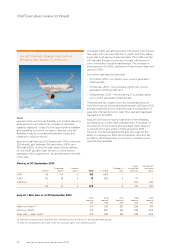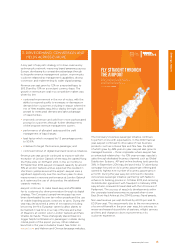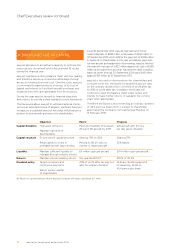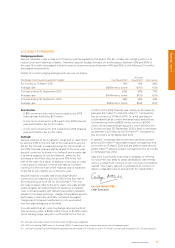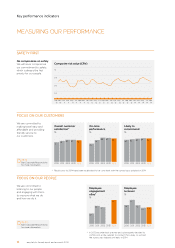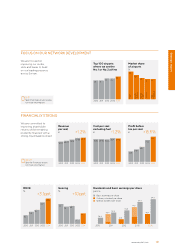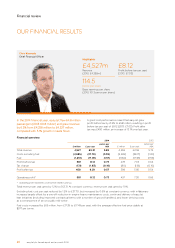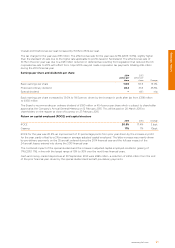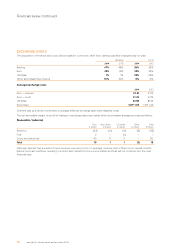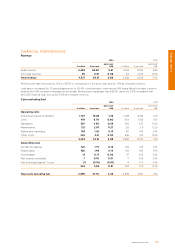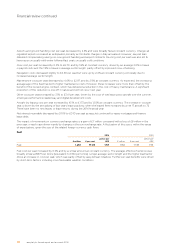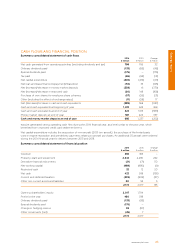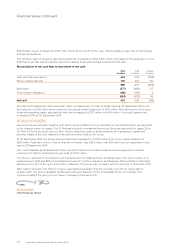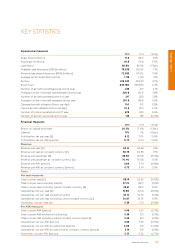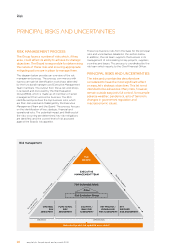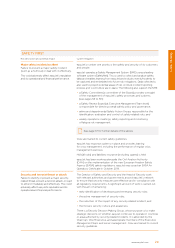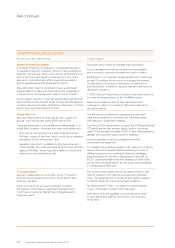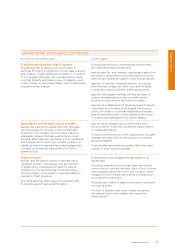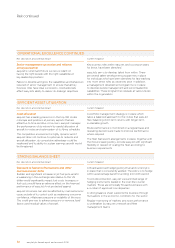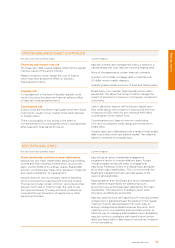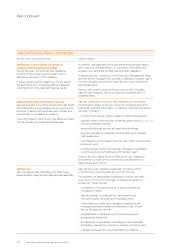EasyJet 2014 Annual Report Download - page 26
Download and view the complete annual report
Please find page 26 of the 2014 EasyJet annual report below. You can navigate through the pages in the report by either clicking on the pages listed below, or by using the keyword search tool below to find specific information within the annual report.
24 easyJet plc Annual report and accounts 2014
Financial review continued
Airports and ground handling cost per seat decreased by 2.3% and were broadly flat at constant currency. Charges at
regulated airports increased as anticipated, primarily as Contratto charges in Italy annualised. However, easyJet lean
delivered compensating savings on new ground handling and airport contracts. De-icing cost per seat was also £0.16
lower as an unusually mild winter followed last year’s unusually cold conditions.
Crew cost per seat increased by 0.3% to £6.70, and by 1.8% at constant currency, driven by an average 2.0% increase
in payroll costs and the 1.9% increase in average sector length, partly offset by improved crew scheduling.
Navigation costs decreased slightly to £4.30 per seat but were up by 2.4% at constant currency principally due to
increased average sector length.
Maintenance costs per seat decreased by 4.6% to £2.97, and by 2.9% at constant currency. As expected, the increasing
average age of the fleet has led to higher maintenance costs. However, these increases were more than offset by the
benefit of the revised engine contract, which has delivered a reduction in the cost of heavy maintenance. A significant
proportion of this reduction is one-off in nature and will not recur next year.
Other costs per seat increased by 3.1% to £3.41 per seat, driven by the cost of wet leasing two aircraft over the summer,
employee performance-related pay and digital development costs.
Aircraft dry leasing cost per seat increased by 16.1% to £1.73 and by 12.5% at constant currency. The increase in cost per
seat is driven by the annualising of last year’s leasing activity, when the leased fleet increased by a net 17 aircraft to 72.
There have been no new leases or lease returns during the 2014 financial year.
Net interest receivable decreased by £0.06 to £0.10 per seat as easyJet continued to repay mortgage and finance
lease debt.
The impact of movements in currency exchange rates is a gain of £7 million compared with a loss of £8 million in the
prior year, in each case driven mainly by changes in the euro exchange rate. A fluctuation of this size is within the range
of expectations, given the size of the related foreign currency cash flows.
Fuel
2014 2013
£ million £ per seat
pence per
ASK £ million £ per seat
pence per
ASK
Fuel 1,251 17.49 1.57 1,182 17.38 1.59
Fuel cost per seat increased by 0.6% and by a similar amount at constant currency. The average effective fuel price was
broadly similar at $977 per tonne (equivalent to £614 per tonne). Longer average sector length and the higher load factor
drove an increase in cost per seat, which was partly offset by easyJet lean initiatives. Further per seat benefits were driven
by short-term factors, including more favourable weather conditions.


